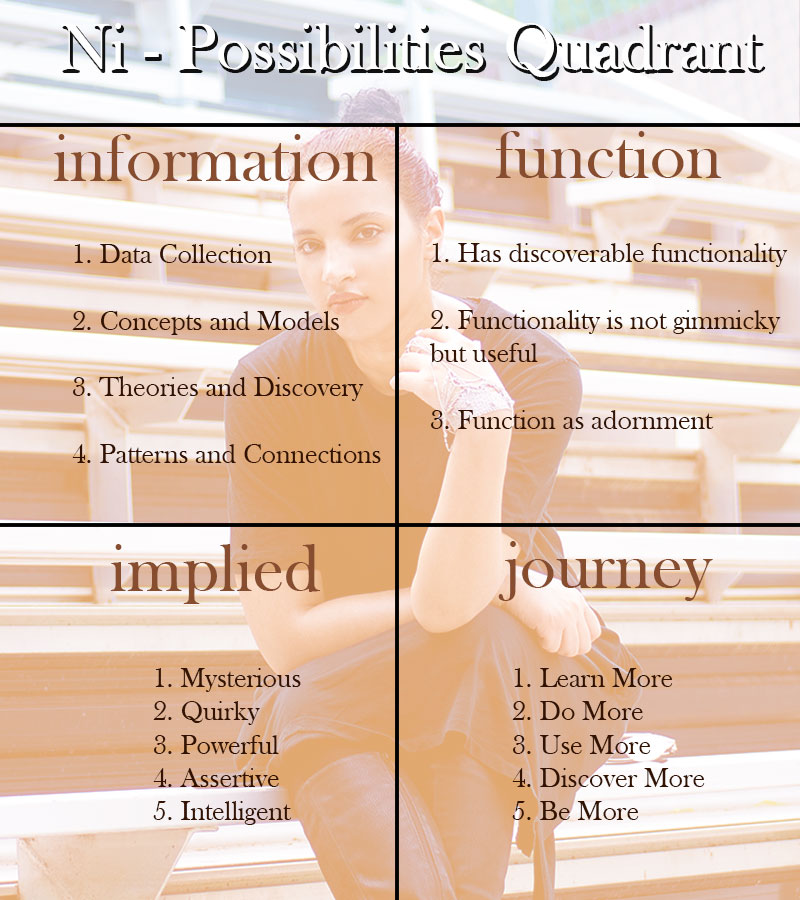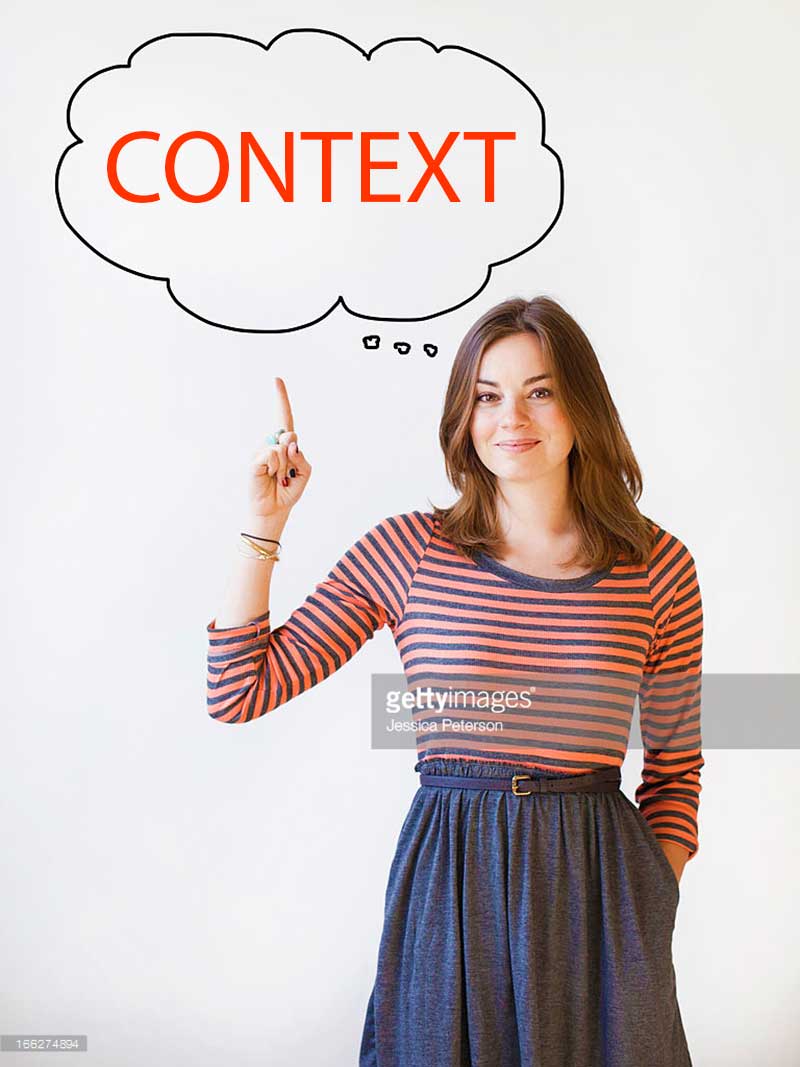Over the past two weeks, we have discussed building customer affinity by utilizing a knowledge of Myers-Briggs typology. Last week, we briefly covered the eight cognitive functions and how targeted branding efforts, focused on meeting the needs of each function, can help to build deeper connections with customers. Today, we will explore four of the cognitive functions in-depth as they apply to one of the rarer 16 personalities—the INTJ. While INTJs don’t make up a large portion of the population, they are a bit of an enigma when it comes to shopping. Possessed of unique interests, they may be just the cognition style you are looking for when selling specialized niche products.
The Functions
Ni- Introverted Intuition – The Possibility Function
INTJs are dominate introverted intuition users (introverted intuitives). Introverted intuition is drawn to mystery, theory, and the unknown. Ni collects information, giving INTJs a sense of what is possible. Because introverted intuition is the INTJ’s dominant function, possibility is also one of the most important buying factors for INTJs. Possibility (in terms of consumerism) typically means that the INTJ will be interested in the following:
- Products that educate
- Products that make them think
- Products that provide new information and ways of seeing the world
- Products that feed into the INTJ’s interest in mystery and the unknown
- Products that allow the INTJ to grow and improve
- And products that deliver a message consistent with the INTJ’s internal values
If your product hits one, or all, of these possibility factors, you can get an INTJ’s attention. We all know that attention is currency in today’s marketplace, but the attention of an INTJ is high value currency, as they tend not to spend it on every cat video or internet meme that comes along. So which product best fits into the possibility category for INTJ purchase factors? If you’re thinking books, you’re right. Books are the most obvious of products to fit the possibility factor. INTJs are avid readers of both fiction and non-fiction. However, just because books are an obvious choice, doesn’t mean that there aren’t other opportunities to capture the attention and interest of an INTJ. Fashion can also fit in the possibility factor — though INTJs are often seen as fashion illiterates. This is a fashion blog, however, so let’s look at how fashion can attract the INTJ through activating possibility to gain the INTJ’s attention.
Activate INTJ attention with any of the possibility-focused themes shown in the quadrant below:

Photo Credit: Alwaysuttori.com
While there is no doubt that fashion is a business. Ample opportunities exist to feed the Ni, thereby drawing INTJ attention. Whether the fashion style is whimsical, quirky, mysterious, fantastical, witty, humorous, or nerdy, it’s important to keep in mind the four keys to feeding the NI, and creating a possibilities connection to the INTJ: identity, function, implied meaning, and journey.
Te- Extroverted Thinking- The Context Function
INTJ’s secondary function is extroverted thinking. However, since INTJs are introverts, they use extroverted thinking to interact with the world over their dominant introverted intuition. Extroverted thinking organizes and analyzes from a big picture perspective. This big picture preference provides context for the INTJ. Context is an analytical factor that focuses on the purpose and overall usability of a product. It is concerned with how others use the product, what others think about the product, how others think the product performs. Basically, INTJs use the context factor to fact check if a product will fit their personal needs based on what others think about it. This is important because if the INTJ doesn’t understand the context of a product, or the context simply doesn’t fit into their lifestyle, the product won’t be purchased. For this reason, context is nearly as important as possibility in the INTJ buying process.
Fi- Introverted Feeling- The Value Factor
Introverted feeling, which is the INTJ’s tertiary (third) function, dictates the INTJ’s values when buying. Introverted feeling works to create harmony within and relates to others through shared experiences. When an INTJ is looking to buy something, the value factor looks for products that resonate with the INTJ’s values on a personal level. Whether the INTJ values frugality and price, quality, practicality, vegan, animal safety, giving back, education, etc, it is the introverted feeling function that houses the INTJ’s personal values. Because introverted feeling is third in the cognition stack, this factor isn’t as important as both possibility and context. INTJ’s must make a conscious effort to take value factors into account when shopping. This means that an INTJ will rarely shop with a focus on values, i.e., only looking to buy products that are made in the USA; but if they stumble upon a product that happens to also fit into a value they hold, the INTJ may be slightly more willing to buy the product. The important thing to remember is values are not a motivational factor for INTJs in relation to shopping; they are merely a supplemental element. However, if your product or brand goes against an INTJ’s values, they will abandon the product all together. While this abandonment may come across as narrow-minded, petty or irrational, the INTJ may not even understand why they have a visceral negative reaction to a product, but this can happen. On the flip side, because values are not a motivating factor, INTJs may still be able to buy the product when focused on the context and possibility factors, but they may feel a sense of shame or guilt associated with the product.
Se- Extroverted Sensing- The Aesthetic factor
The INTJ’s inferior function is extroverted sensing. Low on the cognition stack, INTJs tend to experience extroverted sensing in times of stress. When INTJs are not stressed, extroverted sensing activates an unconscious interest in new experiences and the finer things in life. This represents an INTJ’s personal aesthetic, which in turn will influence the overall look of the products an INTJ finds to be of interest. For the INTJ, the aesthetic factor is so unconscious, it is the least motivating factor in making purchase decisions. Think of it as a function that supplements an INTJ’s buying decisions. Aesthetic also works in tandem with possibility as introverted intuition also influences an INTJ’s aesthetic choices. When an INTJ adopts an aesthetic, they tend to stick with it. Quirky, Sporty, pastel Goth, minimalist, whatever the aesthetic, or aesthetics, an INTJ connects to, they will adhere to these stylistic choices when making purchases. In times of stress, they may impulse shop, over buy, or splurge. While this is good for brands, it’s important that INTJs don’t encounter fabricated stress in the buying process. This will often stall the INTJ and lose the retailer a sale. Having sensing so far back in the cognition stack makes flash sales and other types of sales appealing to this type, but such tactics rarely survive the first three factors long enough to allow for impulse.
Fashion Speaks
Fashion insiders love to use the theme “Fashion Speaks” to cover a variety of topics. Yet, despite the apparent meme(ness) of the phrase, fashion truly does speak – in many different voices. Far more important than what the industry has to say about fashion is the voice of the buyer. The reality is that fashion speaks for and about the wearer— oftentimes in ways the wearer doesn’t realize. For INTJs, who can be very aware of the pitfalls associated with the unstated but implied, fashion can either be perceived as an enemy, or as a statement to the world. Brands and marketers hoping to engage the INTJ should keep the following in mind:
- INTJ buying is most influenced by activating possibility
- INTJ interest can be lost when products are presented without context
- INTJ’s tertiary values function can sway buying choices
- INTJs tend to keep to their aesthetic
- INTJs are strongly aware of the unstated but implied nuances associated with fashion choices. It is up to brands to create implicit messages that capture and resonate with INTJ cognition.
Hopefully, this deep dive into the specific cognitive functions of the INTJ illuminates how helpful MBTI can be in reaching and understanding customers. As always, our views are theoretical in nature, and are best developed with input from others. So please, share your thoughts because We Love Feedback. Thanks for reading.






